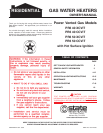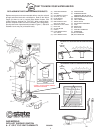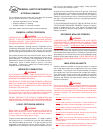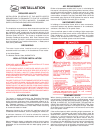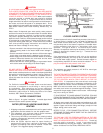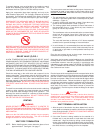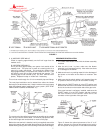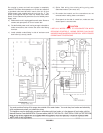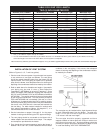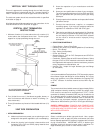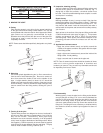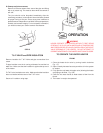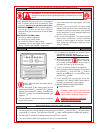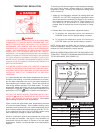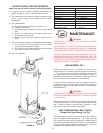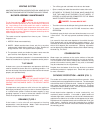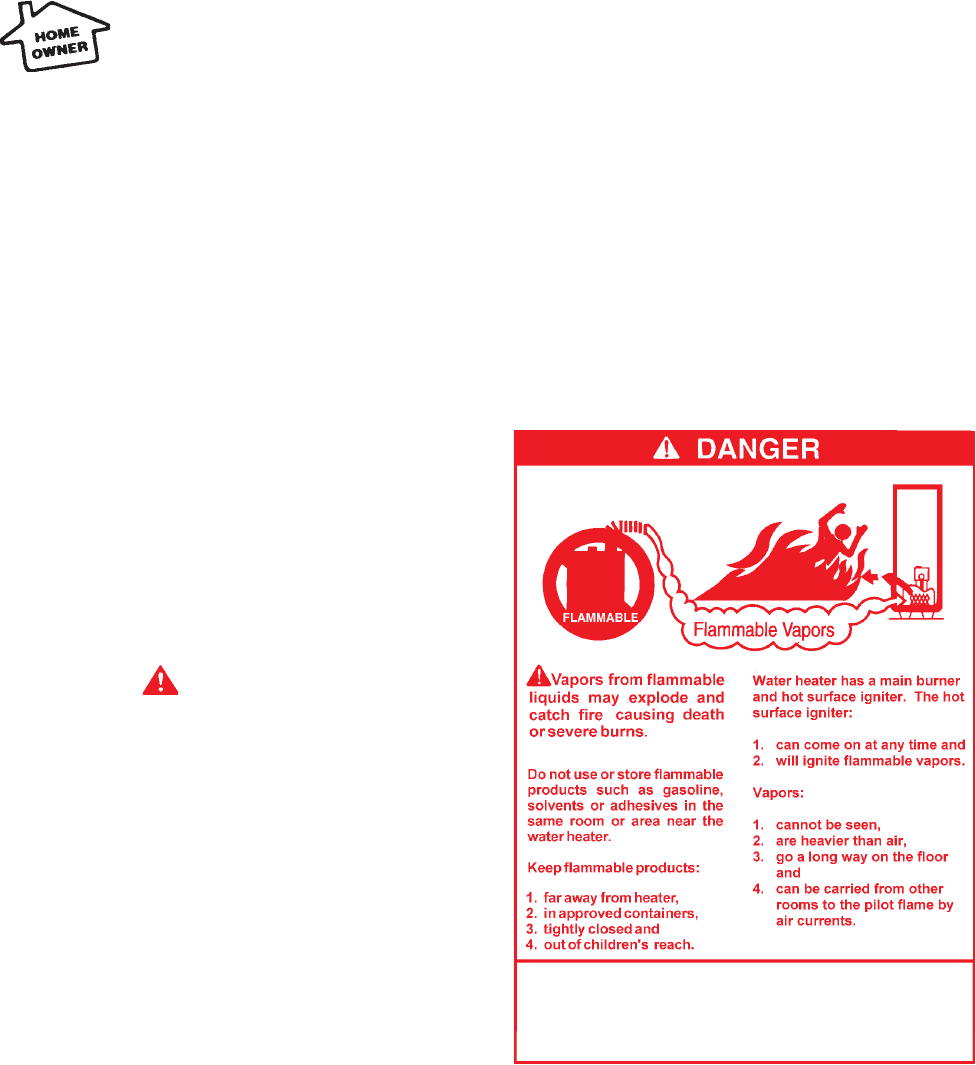
4
AIR REQUIREMENTS
Dilution air temperature must be 100°F or less. In calculating the
free area of a vent opening, the blocking effect of screens, louvers
and grills should be considered. Screens shall not be of a mesh
smaller than 1/4 inch square. If the free area is not known, the
current edition of National Fuel Gas Code ANSI Z223.1/NFPA 54
recommends using figures of 20-25 percent free area for wood
louvers or 60-75 percent for metal grills or louvers.
UNCONFINED SPACE
In buildings of conventional frame, brick or stone construction,
unconfined spaces may provide adequate air for combustion,
ventilation, and dilution air for power venter.
If the unconfined space is within a building of tight construction
(as defined in the most recent revision of the National Fuel Gas
Code Handbook), air for combustion, ventilation, and venter
dilution must be obtained from outdoors. The installation
instructions for confined spaces must be followed.
CONFINED SPACE
When drawing combustion and dilution air from inside a
conventionally constructed building to a confined space, such a
space shall be provided with two permanent openings; ONE
WITHIN 12 INCHES OF THE ENCLOSURE TOP AND ONE IN
OR WITHIN 12 INCHES OF THE ENCLOSURE BOTTOM. Each
opening shall have a free area of one square inch per 1000 Btuh
of the total input of all appliances in the enclosure, but not less
than 100 square inches.
If the confined space is within a building of tight construction, air
for combustion, ventilation and power venter dilution must be
obtained from outdoors. When directly communicating with the
outdoors or communicating through vertical ducts, two
permanent openings, located in the above manner, shall be
provided. Each opening shall have a free area of not less than
one square inch per 4000 Btuh of the total input of all appliances
in the enclosure. If horizontal ducts are used, each opening
shall have a free area of not less than one square inch per 2000
Btuh of the total input of all appliances in the enclosure.
INSTALLATION
REQUIRED ABILITY
INSTALLATION OR SERVICE OF THIS WATER HEATER
REQUIRES ABILITY EQUIVALENT TO THAT OF A LICENSED
TRADESMAN IN THE FIELD INVOLVED. PLUMBING, AIR
SUPPLY, VENTING AND GAS SUPPLY ARE REQUIRED.
GENERAL
The installation must conform to these instructions and the local
code authority having jurisdiction. In the absence of local codes,
the installation must comply with the current editions of the
National Fuel Gas Code ANSI Z223.1/NFPA 54 and the National
Electrical Code, NFPA 70. The former is available from the
Canadian Standards Association, 8501 East Pleasant Valley
Road, Cleveland, OH 44131, and both documents are available
from the National Fire Protection Association, 1 Batterymarch
Park, Quincy, MA 02269.
GROUNDING
The water heater when installed must be grounded in
accordance with local codes, or in the absence of local codes:
In the United States
The National Electric Code, ANSI/NFPA 70.
HIGH ALTITUDE INSTALLATION
WARNING
STANDARD MODELS ARE FOR INSTALLATION UP TO 2,000
FEET (610m) ABOVE SEA LEVEL.
IF A STANDARD MODEL IS INSTALLED ABOVE 2,000 FEET
(610m), INPUT RATING SHOULD BE REDUCED AT A RATE 4
PERCENT FOR EACH 1,000 FEET (305m) ABOVE SEA LEVEL
WHICH REQUIRES REPLACEMENT OF THE BURNER ORIFICE
IN ACCORDANCE WITH THE NATIONAL FUEL GAS CODE
(ANSI Z223.1/NFPA 54).
FAILURE TO REPLACE THE STANDARD ORIFICE WITH A HIGH
ALTITUDE ORIFICE WHEN INSTALLED ABOVE 2,000 FEET
(610m) COULD RESULT IN IMPROPER AND INEFFICIENT
OPERATION OF THE WATER HEATER, PRODUCING CARBON
MONOXIDE GAS IN EXCESS OF SAFE LIMITS, WHICH COULD
RESULT IN SERIOUS INJURY OR DEATH. CONTACT YOUR
LOCAL GAS SUPPLIER FOR ANY SPECIFIC CHANGES WHICH
MAY BE REQUIRED IN YOUR AREA.
LOCATION OF HEATER
The heater is design certified by the Canadian Standards
Association for installation on combustible flooring in a closet
having minimum clearances from combustible material of: 0"
clearance from sides and rear, 5" from the front and 12" from the
top. (Standard clearance.) If clearances stated on the heater
differ from standard clearances, install water heater according
to clearances stated on heater.
Adequate clearance for servicing this appliance should be
considered before installation, such as changing the anodes, etc.
A minimum clearance of 5" must be allowed for access to
replaceable parts such as the thermostats, drain valve and relief
valve.
When installing the heater, consideration must be given to proper
location. Location selected should be as close to the wall as
practicable and as centralized with the water piping system as
possible.
Installation:
Do not install water heater
where
flammable products
will be stored or used
unless the main burner and
hot surface igniter are at
least 18” above the floor.
This will reduce, but not
eliminate, the risk of vapors
being ignited by the main
burner or hot surface
igniter.



